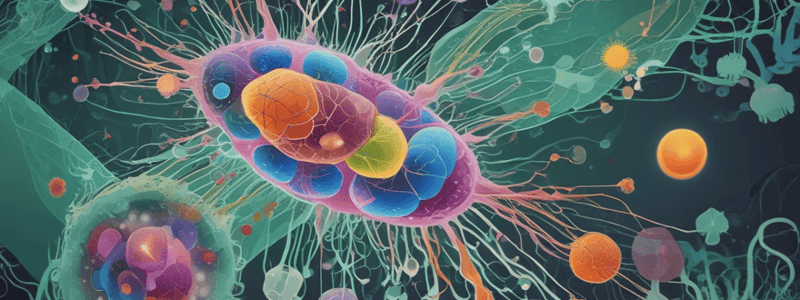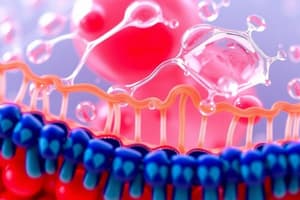Podcast
Questions and Answers
What is the glycocalyx composed of?
What is the glycocalyx composed of?
- Only proteins
- Lipids and nucleic acids
- Polysaccharides, polypeptides, or both (correct)
- Only carbohydrates
What is the primary function of the glycocalyx?
What is the primary function of the glycocalyx?
- Cell signaling
- Protein synthesis
- Protection, adhesion, and signal reception (correct)
- Cell division
Where is the glycocalyx located in relation to the cell wall?
Where is the glycocalyx located in relation to the cell wall?
- External to the cell wall (correct)
- Integrated into the cell wall
- Internal to the cell wall
- Floating freely in the cytoplasm
What is a function of the glycocalyx in terms of cell interactions?
What is a function of the glycocalyx in terms of cell interactions?
What is the nature of the glycocalyx?
What is the nature of the glycocalyx?
What is the primary mechanism by which the glycocalyx protects the cell?
What is the primary mechanism by which the glycocalyx protects the cell?
What is the role of the glycocalyx in cell signaling?
What is the role of the glycocalyx in cell signaling?
What is the advantage of the glycocalyx being composed of polysaccharides and polypeptides?
What is the advantage of the glycocalyx being composed of polysaccharides and polypeptides?
How does the glycocalyx contribute to the cell's adhesion to surfaces and other cells?
How does the glycocalyx contribute to the cell's adhesion to surfaces and other cells?
What is the consequence of a damaged or impaired glycocalyx?
What is the consequence of a damaged or impaired glycocalyx?
Flashcards are hidden until you start studying
Study Notes
Glycocalyx Composition
- Composed primarily of polysaccharides and polypeptides, forming a sticky outer layer on cells.
- Consists of glycoproteins and glycolipids, contributing to its structure and functions.
Primary Function
- Acts as a protective barrier for cells, shielding them from mechanical and chemical damage.
Location
- Located on the external surface of the plasma membrane, overlying the cell wall in prokaryotic cells or directly on eukaryotic cells.
Cell Interactions
- Plays a critical role in facilitating cell-cell recognition and interaction, essential for immune response and tissue formation.
Nature
- Typically a fuzzy, viscous layer, aiding in cellular communication and protection.
Protective Mechanism
- Provides a physical barrier against pathogens, preventing their entry and invasion into cells.
Role in Cell Signaling
- Involved in the binding of signaling molecules, enhancing communication between cells and their environment.
Advantages of Composition
- Polysaccharides and polypeptides offer flexibility and resilience, enabling adaptation to various environments and interactions.
Adhesion Contribution
- Enhances cell adhesion to surfaces and other cells through specific molecular interactions, promoting tissue integrity and functionality.
Consequences of Damage
- Damage or impairment of the glycocalyx can lead to increased susceptibility to infections, inflammation, and impaired cell signaling, ultimately affecting cellular health.
Studying That Suits You
Use AI to generate personalized quizzes and flashcards to suit your learning preferences.




